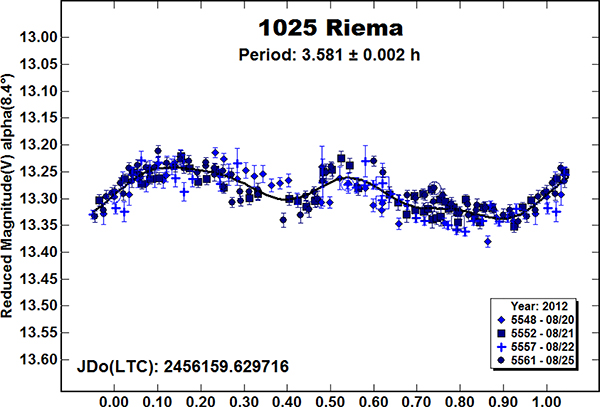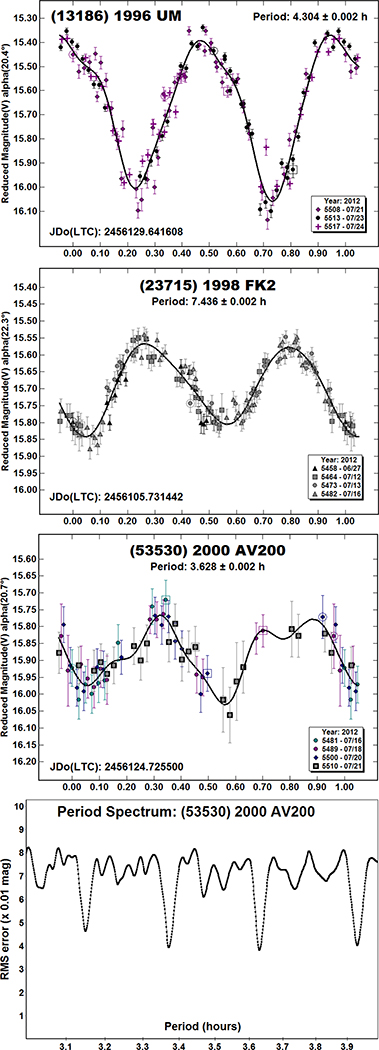Abstract
Lightcurves for 10 asteroids were obtained at the Palmer Divide Observatory (PDO) from 2012 June to August: 1025 Riema, 1685 Toro, 3022 Dobermann, 6403 Steverin, 9564 Jeffwynn, (11904) 1991 TR1, (13186) 1996 UM, (23715) 1998 FK2, (53530) 2000 AV200, and (86257) 1999 TK207. Analysis of data from 2007 revised the previously reported period for (11904) 1991 TR1.
CCD photometric observations of 10 asteroids were made at the Palmer Divide Observatory (PDO) from 2012 June to September. See the introduction in Warner (2010) for a discussion of equipment, analysis software and methods, and overview of the lightcurve plot scaling. The “Reduced Magnitude” in the plots is Johnson V or Cousins R (indicated in the Y-axis title) corrected to unity distance by applying −5*log (rA) with r and A being, respectively, the Sun-asteroid and Earth-asteroid distances in AU. The magnitudes were normalized to the phase angle given in parentheses, e.g., alpha(6.5°), using G = 0.15 unless otherwise stated.
For the sake of brevity in the following discussions on specific asteroids, only some of the previously reported results are referenced. For a more complete listing, the reader is referred to the asteroid lightcurve database (LCDB, Warner et al., 2009). The on-line version allows direct queries that can be filtered a number of ways and the results saved to a text file. A set of text files, including the references with Bibcodes, is also available for download at http://www.minorplanet.info/Ughtcurvedatabase.html. Readers are strongly encouraged to obtain, when possible, the original references listed in the LCDB for their work.
1025 Riema
This Hungaria asteroid was previously worked by Shevchenko (2003), who found a period of 6.557 h. Subsequent work by Stephens (2003) found 3.580 h. Warner (2009) reported a period of 3.566 h. The latter data set was relatively sparse, which may explain the discrepancy with the Stephens period. The latest set of 195 data points gives a period of 3.581 h. The period spectrum included here, covering 3–7 h, indicates a strong preference for the 3.58 h solution over that from Shevchenko.
1685 Toro
Observations of this near-Earth asteroid (NEA) were made in July and August to support radar modeling. The period of about 10.195 h had been previously established on several occasions, e.g., Dunlap (1973) and Higgins (2008). The observations in late July were made at a phase angle of about 75°. At that time the amplitude of the lightcurve was 1.38 ± 0.02 mag and the synodic period was 10.226 ± 0.002 h. Additional observations in late August were at phase angle 97°, when the synodic period had decreased to 10.188 ± 0.002 h but the amplitude increased to 1.80 ± 0.02 mag. These are not unexpected changes with the increasing phase angle and will help the modeling process more than having just one curve or the other.
3022 Dobermann
This was the third apparition at which observations of this Hungaria asteroid were made. The period was found to be 10.32 h in 2004 (Warner, 2005) and 10.330 h in 2011 (Warner, 2011). Angeli (2001) found a period of 10.49 h, but none of the three data sets from PDO can be made to fit this solution. The results from the 2012 campaign were in close agreement with the two previous results from Warner.
6403 Steverin
This is a Eunomia family member that was worked by Warner (2005), who found a period of 3.485 h. The period of 3.4903 h found in 2012 is in good agreement with that result.
9564 Jeffywnn
This Mars-crosser was a “full moon project”, meaning it was bright enough while the moon was near full and other in-progress targets too faint. There were no previous results found in the LCDB.
(11904) 1991 TR1
This Hungaria asteroid was originally reported to have a period of 9.123 h (Warner, 2008) based on a monomodal curve and despite an amplitude of 0.31 mag. Harris (2012) has shown that at relatively low phase angles (6° in 2008), this combination is almost physically impossible and that a bimodal solution was the right solution. Another analysis of the 2007 data found a bimodal lightcurve with a period of 18.233 ± 0.003 h. The data in 2012 were of considerably less quality, being much fewer and noisier due to the asteroid being in crowded star fields. What data were available were forced to a period near the revised period. The result is not at all convincing. Observations at future apparitions are planned at PDO and encouraged elsewhere.
(13186) 1996 UM and (23715) 1998 FK2
No previous results were found in the LCDB for these two Hungarias.
(53530) 2000 AV200
The plot for this Hungaria is for one of several possible periods between 3–4 hours. The period spectrum shows that periods of 3.374 and 3.932 h cannot be formally excluded. However, the plot at 3.628 h shows a better overall shape in terms of symmetry. No previous results were listed in the LCDB.
(86257) 1999 TK207
The period of 32.408 ± 0.005 h is in good agreement with the one of 32.49 h (Warner, 2011) given the sparser data set and gaps in coverage for the earlier result.
Table I.
Observing circumstances. Asteroids with (H) after the name are members of the Hungaria group/family. The phase angle (α) is given at the start and end of each date range, unless it reached a minimum, which is then the second of three values. If a single value is given, the phase angle did not change significantly and the average value is given. LPAB and BPAB are each the average phase angle bisector longitude and latitude, unless two values are given (first/last date in range).
| Number | Name | 2012 (mm/dd) | Pts | Phase | LPAB | BPAB | Period | P.E. | Amp | A.E. |
|---|---|---|---|---|---|---|---|---|---|---|
| 1025 | Riema (H) | 08/20–08/25 | 195 | 8.3,8.7 | 325 | 12 | 3.581 | 0.002 | 0.10 | 0.01 |
| 1685 | Toro | 07/24–07/26 | 167 | 73.3,75.9 | 353,356 | 18 | 10.226 | 0.002 | 1.38 | 0.02 |
| 1685 | Toro | 08/13–08/17 | 167 | 95.1,97.5 | 25,32 | 24 | 10.188 | 0.002 | 1.80 | 0.02 |
| 3022 | Dobermann (H) | 08/26–09/10 | 305 | 12.5,15.0 | 331 | 17 | 10.333 | 0.001 | 0.87 | 0.02 |
| 6403 | Steverin | 07/16–07/23 | 274 | 10.5,10.4 | 298 | 19 | 3.4905 | 0.0003 | 0.47 | 0.02 |
| 9564 | Jeffwynn | 08/31–09/06 | 280 | 15.7,12.9 | 345 | 16 | 3.035 | 0.001 | 0.16 | 0.02 |
| 11904 | 1991 TR1 (H) | 11/02–11/07* | 308 | 7.6,4.2 | 49 | −1 | 18.233 | 0.003 | 0.32 | 0.02 |
| 11904 | 1991 TR1 (H) | 07/26–08/25 | 94 | 22.3,21.9,23.8 | 314 | 30 | 18.34 | 0.05 | 0.11 | 0.02 |
| 13186 | 1996 UM (H) | 07/21–07/24 | 128 | 20.4,20.0 | 308 | 30 | 4.304 | 0.002 | 0.69 | 0.02 |
| 23715 | 1998 FK2 (H) | 06/27–07/16 | 140 | 22.2,21.9,22.2 | 285 | 32 | 7.436 | 0.002 | 0.27 | 0.02 |
| 53530 | 2000 AV200 (H) | 07/16–07/21 | 59 | 20.5,22.1 | 262 | 16 | 3.628 | 0.002 | 0.26 | 0.02 |
| 86257 | 1999 TK207 (H) | 07/12–0726 | 428 | 14.9,11.0 | 311 | 11 | 32.408 | 0.005 | 1.51 | 0.02 |
2007
Acknowledgements
Funding for observations at the Palmer Divide Observatory is provided by NASA grant NNX10AL35G, by National Science Foundation grant AST-1032896.
References
- Angeli CA, Guimaraes TA, Lazzaro D, Duffard R, Fernández S, Florczak M, Mothé-Diniz T, Carvano JM, and Betzler AS (2001). “Rotation Periods for Small Main-Belt Asteroids from CCD Photometry.”Astron. J 121, 2245–2252. [Google Scholar]
- Dunlap JL, Gehrels T, and Howes ML (1973). “Minor planets and related objects: IX. Photometry and polarimetry of (1685) Toro.” Astron. J. 78, 491–501. [Google Scholar]
- Harris AW (2012). “On the Maximum Amplitude of Harmonics of an Asteroid Lightcurve.” in Proceedings for the 31st Annual Symposium on Telescope Science (Warner BD, Buchheim RK, Foote JL, Mais D, eds.) pp 59–63. Society for Astronomical Sciences. Rancho Cucamonga, CA. [Google Scholar]
- Higgins D (2008). “Asteroid Lightcurve Analysis at Hunters Hill Observatory and Collaborating Stations: April 2007 - June 2007.” Minor Planet Bul. 35, 30–32. [Google Scholar]
- Shevchenko VG, Krugly, Yu N, Chiorny VG, Belskaya IN, and Gaftonyuk NM (2003). “Rotation and photometric properties of E-type asteroids.” Planet. Space Sci. 51, 525–532. [Google Scholar]
- Stephens RD (2003). “Photometry of 628 Christine, 754 Malabar, 815 Coppelia, and 1025 Riema.” Minor Planet Bul. 30, 69–70. [Google Scholar]
- Warner BD (2005). “Lightcurve analysis for asteroids 242, 893, 921, 1373, 1853, 2120, 2448 3022, 6490, 6517, 7187, 7757, and 18108.” Minor Planet Bul 32, 47. [Google Scholar]
- Warner BD (2005). “Asteroid lightcurve analysis at the Palmer Divide Observatory - Fall 2004.” Minor Planet Bul. 32, 29–32. [PMC free article] [PubMed] [Google Scholar]
- Warner BD (2008). “Asteroid Lightcurve Analysis at the Palmer Divide Observatory: September-December 2007.” Minor Planet Bul. 35, 67–71. [PMC free article] [PubMed] [Google Scholar]
- Warner BD (2009). “Asteroid Lightcurve Analysis at the Palmer Divide Observatory: 2009 March - June.” Minor Planet Bul. 36, 172–176. [PMC free article] [PubMed] [Google Scholar]
- Warner BD (2010). “Asteroid Lightcurve Analysis at the Palmer Divide Observatory: 2010 March - June.” Minor Planet Bul. 37, 161–165. [PMC free article] [PubMed] [Google Scholar]
- Warner BD (2011). “Asteroid Lightcurve Analysis at the Palmer Divide Observatory: 2011 March-July.” Minor Planet Bul. 38, 190–195. [PMC free article] [PubMed] [Google Scholar]
- Warner BD, Harris AW, and Pravec P (2009). “The Asteroid Lightcurve Database.” Icarus 202, 134–146. [Google Scholar]






